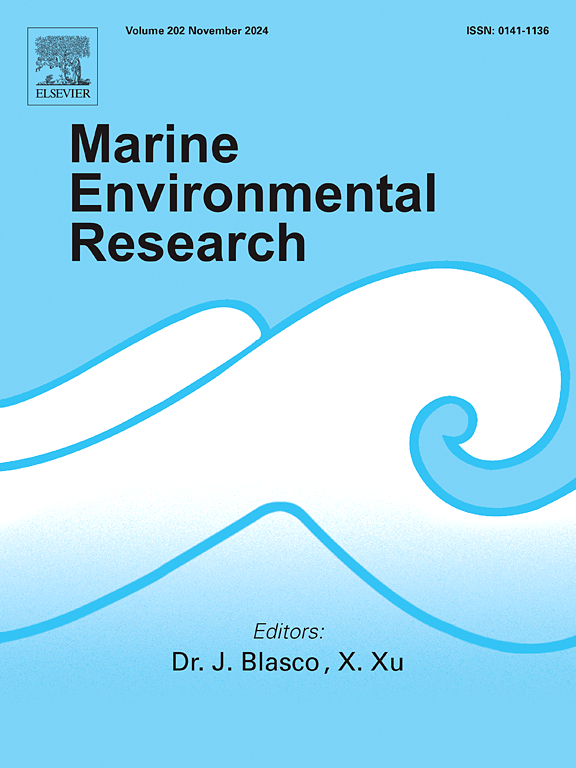Effects of vessels on common dolphin activity patterns in a critical area for the species. Conservation implications
IF 3
3区 环境科学与生态学
Q2 ENVIRONMENTAL SCIENCES
引用次数: 0
Abstract
Although whale-watching tourism makes it easier for humans to learn about these animals in the wild, interactions with boats can trigger temporary or even permanent behavioural changes in their populations. In this work we studied the potential effect of boats on the welfare of common dolphins, Delphinus delphis, a protected species in the Mediterranean, as well as a female bottlenose dolphin (Billie-Tursiops truncatus) that coexists with them in the bay of Algeciras-Gibraltar (BA-G), Southern Spain and that gave birth to the first known hybrid between both species in the wild. First, the reaction of the animals (Approach, Elusive and Indifference) to the presence of boats was observed. Subsequently, we have classified the sightings into four situations: Control (C) and Impact (I) with Regulated (RS) and Unregulated (US) sightings. In each situation, six behavioural states were distinguished: Feeding (F), Resting (R), Milling (M), Socialising (S), Travelling (T) and Diving (D). It was concluded that the presence of boats and non-compliance with the protocol for approaching cetaceans were the main causes of the behavioural transitions and that they led to an absorbing D state in the Markov chains. The results showed that the feeding and resting behaviours of the dolphins were significantly altered. Possible alteration of these behaviours may have negative effects on the animals. Our results are further evidence of the need to regulate and monitor vessel activities to protect common dolphins in BA-G, a critical area for this species, which still lacks specific conservation plans.

船只对海豚活动模式的影响。保护的影响
虽然观鲸旅游使人类更容易了解这些野生动物,但与船只的互动可能会引发它们种群的暂时甚至永久的行为变化。在这项工作中,我们研究了船只对普通海豚(地中海受保护物种Delphinus delphis)以及西班牙南部阿尔赫西拉斯-直布罗陀湾(BA-G)中与它们共存的雌性宽吻海豚(bile - tursiops truncatus)的福利的潜在影响,并在野外生下了已知的第一个两种海豚的杂交后代。首先,观察了动物对船只的反应(接近,难以捉摸和冷漠)。随后,我们将目击事件分为四种情况:控制(C)和影响(I),管制(RS)和不管制(US)目击事件。在每种情况下,区分了六种行为状态:进食(F),休息(R),磨磨(M),社交(S),旅行(T)和潜水(D)。得出的结论是,船只的存在和不遵守接近鲸类的协议是行为转变的主要原因,它们导致马尔可夫链中的吸收D状态。结果表明,海豚的进食和休息行为发生了显著变化。这些行为的可能改变可能对动物产生负面影响。我们的研究结果进一步证明,需要规范和监测船只活动,以保护BA-G地区的普通海豚,这是该物种的关键区域,但仍缺乏具体的保护计划。
本文章由计算机程序翻译,如有差异,请以英文原文为准。
求助全文
约1分钟内获得全文
求助全文
来源期刊

Marine environmental research
环境科学-毒理学
CiteScore
5.90
自引率
3.00%
发文量
217
审稿时长
46 days
期刊介绍:
Marine Environmental Research publishes original research papers on chemical, physical, and biological interactions in the oceans and coastal waters. The journal serves as a forum for new information on biology, chemistry, and toxicology and syntheses that advance understanding of marine environmental processes.
Submission of multidisciplinary studies is encouraged. Studies that utilize experimental approaches to clarify the roles of anthropogenic and natural causes of changes in marine ecosystems are especially welcome, as are those studies that represent new developments of a theoretical or conceptual aspect of marine science. All papers published in this journal are reviewed by qualified peers prior to acceptance and publication. Examples of topics considered to be appropriate for the journal include, but are not limited to, the following:
– The extent, persistence, and consequences of change and the recovery from such change in natural marine systems
– The biochemical, physiological, and ecological consequences of contaminants to marine organisms and ecosystems
– The biogeochemistry of naturally occurring and anthropogenic substances
– Models that describe and predict the above processes
– Monitoring studies, to the extent that their results provide new information on functional processes
– Methodological papers describing improved quantitative techniques for the marine sciences.
 求助内容:
求助内容: 应助结果提醒方式:
应助结果提醒方式:


